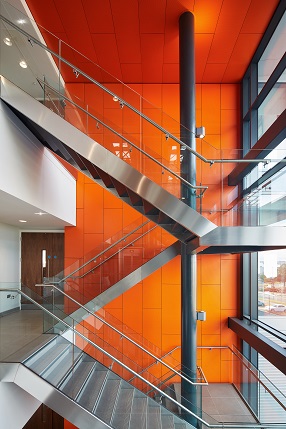Leading Brazilian architect to receive UK’s highest honour for architecture The Royal Institute of British Architects (RIBA) is delighted to announce that Paulo Mendes da Rocha, Brazil’s most celebrated living architect, will receive the 2017 Royal Gold Medal. Given in recognition of a lifetime’s work, the Royal Gold Medal is approved by Her Majesty The Queen and is given to a person or group of people who have had a significant influence “either directly or indirectly on the advancement of architecture”. Awarded since 1848, past Royal Gold Medallists include Zaha Hadid (2016), Frank Gehry (2000), Norman Foster (1983), Frank Lloyd Wright (1941) and Sir George Gilbert Scott (1859); Oscar Niemeyer (1998) is the only other Brazilian architect to have received the honour. Born in Vitória, Brazil in 1928, Paulo Mendes da Rocha has received international acclaim for his significant contribution to architecture. Mendes da Rocha’s numerous notable cultural buildings, built in his particular Brazilian Brutalist style with exposed concrete structures and rough finishes, are widely credited with transforming the city of São Paulo. In 1957 he completed his first celebrated building, the Athletic Club of São Paulo, followed by a large number of further public buildings in the city including Saint Peter Chapel (1987), the Brazilian Sculpture Museum MuBE (1988), Patriach Plaza (1992-2002), the Pinacoteca do Estado gallery (1993) and the FIESP Cultural Center (1997). Outside São Paulo, notable buildings include the Serra Dourada football stadium in Goiás (1973), Lady of the Conception Chapel in Recife (2006) and Cais das Artes arts centre in Vitória (2008). Despite Mendes da Rocha’s international reputation, there have been just a few chances to experience his work outside his home country, with the significant exception of Brazil’s pavilion at Expo ’70 (Osaka, Japan) and Portugal’s National Coach Museum (Lisbon, 2015). Speaking about the award, RIBA President and chair of the selection committee Jane Duncan said: “Paulo Mendes da Rocha’s work is highly unusual in comparison to the majority of the world’s most celebrated architects. He is an architect with an incredible international reputation, yet almost all his masterpieces are built exclusively in his home country. Revolutionary and transformative, Mendes da Rocha’s work typifies the architecture of 1950s Brazil – raw, chunky and beautifully ‘brutal’ concrete. “Paulo Mendes da Rocha is a world-class architect and a true living legend; I am delighted he will be presented with the Royal Gold Medal, one of the world’s most important honours for architecture.” Paulo Mendes da Rocha said: “After so many years of work, it is a great joy to receive this recognition from the Royal Institute of British Architects for the contribution my lifetime of work and experiments have given to the progress of architecture and society. I would like to send my warmest wishes to all those who share my passion, in particular British architects, and share this moment with all the architects and engineers that have collaborated on my projects.” Paulo Mendes da Rocha has previously been honoured with the Mies van der Rohe Prize (2000), Pritzker Prize (2006), the Venice Biennale Golden Lion for lifetime achievement (2016) and the Praemium Imperiale International Arts Award (2016). The Royal Gold Medal will be presented to Paulo Mendes da Rocha in early 2017. ENDS Notes to editors: 1. For more press information contact: Melanie Mayfield melanie.mayfield@riba.org 020 7307 3662 2. Images can be downloaded from https://riba.box.com/s/9uartks04ojanjztyndlvrz6zflzuttx 3. For more information on the Royal Gold Medal visit https://www.architecture.com/RIBA/Awards/RoyalGoldMedal/RoyalGoldMedal.aspx 4. The 2017 Royal Gold Medal selection committee comprises RIBA President Jane Duncan with Sir Peter Cook, Neil Gillespie OBE, Victoria Thornton OBE and the 2015 Royal Gold Medallist Sheila O’Donnell. 5. The Royal Institute of British Architects (RIBA) is a global professional membership body that serves its members and society in order to deliver better buildings and places, stronger communities and a sustainable environment. www.architecture.com Follow us on Twitter for regular RIBA updates www.twitter.com/RIBA 6. Paulo Mendes da Rocha – Biography Paulo Mendes da Rocha was born in October 1928 in the city of Vitória- the harbor capital of Espírito Santo, son of the naval engineer Paulo Menezes Mendes da Rocha and Angelina Derenzi, daughter of an Italian family that had emigrated to Brazil. When his father assumed the coordination of the Naval and Harbor discipline at the Polytechnic School of the São Paulo University (USP) in 1940, the family moved to São Paulo. Paulo Mendes da Rocha graduated from the Mackenzie University Architecture School in 1954 and built a career planning houses, schools, apartment buildings, museums, several urban projects, stations and sport equipment, furniture and theatre sets. Soon after his graduation, in 1957 he won a national competition for the construction of a gymnasium – the Clube Atlético Paulistano. This work brought him public recognition and won the principal award at the 6th Bienal of São Paulo, in 1961 – Grande Prêmio Presidência da República. In 1968, he won the national project competition for the Brazilian Pavilion at Osaka Expo 70 and travelled to follow the development of the construction in 1969. Among several international honors, he has been awarded with the Mies Van der Rohe Foundation Prize for his Pinacoteca de São Paulo project. He was selected in 2000 to represent Brazil at the 7th International Architecture Exhibition of La Biennale di Venezia. He received the Pritzker Architecture Prize in 2006. In Brazil, he was twice honored with the Ordem do Mérito Cultural, in 2004 and 2013. He also received twice the trophy from APCA “Associação Paulista de Críticos de Arte”, in 2012 and 2015. In 2016, he was awarded with the Golden Lion for lifetime achievement at Venice Architecture Biennale and with the Imperiale Praemium in honour of Prince Takamatsu in the category of architecture in Japan. He joined the academic world in the sixties when invited to teach at the School of Architecture and Urbanism at the University of São Paulo. He taught at the University of São Paulo from 1960 to 1969 and from 1980 till 1998; in 2010 he received the title









